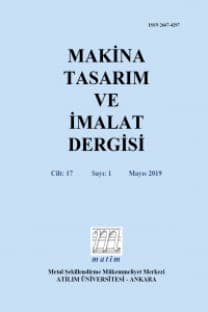Plastiklik Özelliği Son Derece Sınırlı Olan Yüksek Dayanımlı Paslanmaz Çelik Sacların Hassas Kesilebilme Kabiliyeti Üzerine Kalıp Profil Geometrisinin Etkisi
Hassas kesme işlemi, dar boyutsal toleranslara sahip ve kesme yüzey kalitesinin, geleneksel kesme yöntemleri ile kıyaslandığında çok daha üstün olmasının istendiği sac parçaların imalatı için başvurulan özel bir yöntemdir. Sac malzeme özellikleri ile kesme kalıbının tasarımı ve işlem parametreleri, sac metallerin hassas kesilebilme kabiliyetine etki eden başlıca faktörlerdir. Bu çalışmada, otomotivde yakıt sistemlerinde kullanılan, yüksek dayanımlı ve plastiklik özelliği çok sınırlı olan DIN 1.4310 kalitesindeki paslanmaz çelik sacdan mamul bir pul için hassas kesme prosesi sayısal olarak incelenmiştir. Seçilen üç farklı kalıp profil geometrisinde, sonlu elemanlar yöntemine dayalı analizler ile bu sacın hassas kesilebilme kabiliyeti araştırılmıştır. Kalıp kesme ağzında düz profilden kademeli geometrilere geçildikçe, kesme yüzeylerinde kopmanın azaldığı ve yüzey kalitesinin iyileştiği görülmüştür. Tek kör bilemeli kalıp profili ile kesme yüzey kalitesi belli düzeyde iyileşirken; pulun silindirik taşlanmasına gerek duyulmayacak şekilde en iyi kesme yüzey kalitesine, çift kademeli kör bileme ve bu iki bileme arasında bir kalibrasyon düzlüğü içeren kalıp profiliyle ulaşılmıştır. Diğer yandan, ağır bir hidrostatik basınç altında gerçekleşen kesme nedeniyle pul alın yüzeyinde ortaya çıkan bombeleşmenin, kademeli profillerle tasarlanan kalıplarda daha fazla olduğu saptanmıştır. Dolayısıyla, hassas kesme proses parametreleri optimize edilmedikçe, alın taşlama ile pulda bir ek bitirme işleminin gerekli olacağı görülmüştür.
Anahtar Kelimeler:
Sac metal, hassas kesme, DIN 1.4310, paslanmaz çelik, yüksek dayanım, düşük plastiklik özelliği, sonlu elemanlar analizi, kalıp tasarımı, profil geometrisi, yüzey kalitesi, bombeleşme
___
- 1 Mucha, J., An Experimental Analysis of Effects of Various Material Tool’s Wear on Burr During Generator Sheets Blanking, The International Journal of Advanced Manufacturing Technology, 50 (2010) 5-8, 495-507.
- 2 Schmidt, R.A., Birzer, F., Höfel, P., Reh, B., Hellman, M., Rademacher, P. ve Hoffmann, H., Cold Forming and Fineblanking, A Handbook, Buderus Edelstahl Bad GmbH, Feintool Technologies AG Lyss, Hoesch Hohenlimburg GmbH, Unternehmensgruppe C.D. Walzholz GmbH und Co.KG, Germany, 2007.
- 3 Aravind, U., Gopalakrishnan, C. K., Uday, C. ve Venugopal, P., The Effect of Using Rubber for Applying Counter Force in Fine Blanking of AISI 304 Stainless Steel, Procedia Engineering, 207 (2017), 1523-1527.
- 4 Zhuang, X., Ma, S. ve Zhao, Z., A Microstructure-Based Macro-Micro MultiScale Fine-Blanking Simulation of FerriteCementite Steels, International Journal of Mechanical Sciences, 128 (2017), 414-427.
- 5 Taşdemir, V., Hassas Kesme İşlemine Malzeme Kalınlığı ve Kalıp Boşluğunun Etkisinin Sonlu Elemanlar Yöntemi ile Analizi, Uluslararası Mühendislik Araştırma ve Geliştirme Dergisi, 10 (2018) 2, 127-134.
- 6 Majerniková, J. ve Spišák, E., The Effect of Punch-Die Clearance on Blanked Edge Quality in Fine Blanking of Steel Sheets, Zeszyty Naukowe Politechniki Rzeszowskiej. Mechanika, 85 (2013) 4, 479-488.
- 7 Wang, J. P., A Novel Fine-Blanking Approach, The International Journal of Advanced Manufacturing Technology, 78 (2015) 5-8, 1015-1019.
- 8 Luo, C., Chen, Z., Zhou, K., Yang, X. ve Zhang, X., A Novel Method to Significantly Decrease the Die Roll During Fine-Blanking Process with Verification by Simulation and Experiments, Journal of Materials Processing Technology, 25 (2017), 254-260.
- 9 Thipprakmas, S., Application of Taguchi Technique to Investigation of Geometry and Position of V-Ring Indenter in Fine-Blanking Proces, Materials & Design (1980-2015), 31 (2010) 5, 2496-2500.
- 10 Wang, C., Liu, Y., Wan, S., Guo, B., Shan, D. ve Zhang, B., Effect of Ultrasonic Vibration on Deformation in Micro-Blanking Process with Copper Foil, Journal of Wuhan University of Technology-Mater. Sci. Ed., 34 (2019) 2, 404-409.
- 11 Liu, Y., Tang, B., Hua, L. ve Mao, H., Investigation of a Novel Modified Die Design for Fine-Blanking Process to Reduce the DieRoll Size, Journal of Materials Processing Technology, 260 (2018), 30-37.
- 12 Mao, H., Zhou, F., Liu, Y. ve Hua, L., Numerical and Experimental Investigation of the Discontinuous Dot İndenter in the FineBlanking Process, Journal of Manufacturing Processes, 24 (2016), 90-99.
- 13 Zhao, P. J., Chen, Z. H. ve Dong, C. F., Experimental and Numerical Analysis of Micromechanical Damage for DP600 Steel in Fine-Blanking Process, Journal of Materials Processing Technology, 236 (2016), 16-25.
- 14 Thipprakmas, S., Improving Wear Resistance of Sprocket Parts Using a Fine-Blanking Process, Wear, 271 (2011) 9-10, 2396-2401.
- 15 Fan, W. F. ve Li, J. H., An Investigation on the Damage of AISI-1045 and AISI-1025 Steels in Fine-Blanking with Negative Clearance, Materials Science and Engineering: A, 499 (2009) 1-2, 248-251.
- 16 Zheng, Q., Zhuang, X. ve Zhao, Z., State-ofthe-Art and Future Challenge in FineBlanking Technology, Production Engineering, 13 (2019), 61–70.
- 17 Bao, Y. ve Wierzbicki, T., On Fracture Locus in the Equivalent Strain and Stress Triaxiality Space, International Journal of Mechanical Sciences, 46 (2004), 81-98.
- 18 Hosford, W.F. ve Caddell, R.M., Metal Forming- Mechanics and Metallurgy (4th Edition), Cambridge University Press, New York, 2011.
- 19 Wu, P.D., Embury, J.D., Lloyd, D.J., Huang, Y. ve Neale, K.W., Effects of Superimposed Hydrostatic Pressure on Sheet Metal Formability, International Journal of Plasticity, 25 (2009) 9, 1711-1725.
- 20 Peng, J., Wu, P.D., Huang, Y., Chen, X.X., Lloyd, D.J., Embury, J.D. ve Neale, K.W., Effects of Superimposed Hydrostatic Pressure on Fracture in Round Bars under Tension, International Journal of Solids and Structures, 46 (2009) 20), 3741-3749.
- ISSN: 1302-9487
- Başlangıç: 1986
- Yayıncı: Makina Tasarım ve İmalat Derneği
Sayıdaki Diğer Makaleler
Bora ŞENER, Elif Sıla SELEK KILIÇARSLAN, Mehmet FIRAT
Genelleştirilmiş Plastik Deformasyon İş Kriterinin Hasar Tahmin Kabiliyeti
Toros Arda AKSEN, Bora ŞENER, Mehmet FIRAT
Umut Karagüzel, Ali Taner KUZU, Mustafa Bakkal
Cevat ÇİÇEK, Cemil Günhan ERHUY, Hasan KINAGU, Niyazi EFE, Onur SARAY
Kişiselleştirilmiş Robot Tasarımı için Kavramsal Tasarım Metodolojisi
